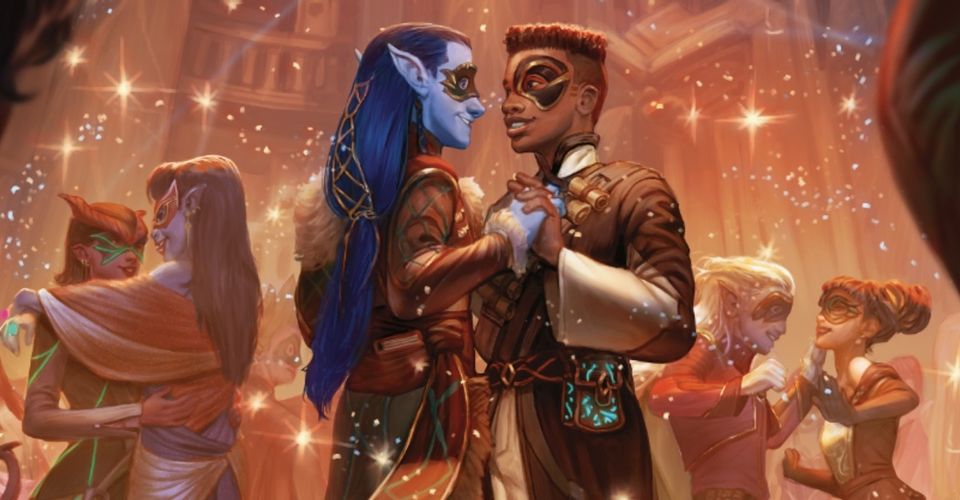How To Offer Non-Intrusive Romance In A D&D Campaign

Adventures in Dungeons & Dragons are often comprised of exploration, combat, and intrigue as the party unravels the storyline presented by the Dungeon Master. While D&D’s gameplay primarily revolves around the party working together to solve problems or overcome enemies, there is also the chance for romance to unfold between party member characters or with DM-controlled NPCs. While the inclusion of romance can be difficult to navigate during gameplay, with some DMs choosing to omit these interactions, others may include the option to add further social elements for players to explore.
The first thing to consider when choosing to add romance into a D&D campaign is party consent. While some players may be interested in romancing or seducing the main villain, or falling in love with an NPC in a tavern, other players might feel uncomfortable being involved in or having to watch other Dungeons & Dragons party members engage in these types of character interactions. Because of this, a DM should always touch bases with potential players before starting a campaign to see if it is something the party is okay with being included in their adventures. It is also possible the opportunity for a romantic relationship may unfold naturally later in a campaign, at which point the players and DM can discuss if the relationship is something that should be included in active gameplay, or if it would create awkward pauses and problems for the adventure as a whole.
When including romance in a Dungeons & Dragons campaign, the DM will want to plan ahead and decide which characters have the ability to be propositioned by party members. Much like dateable NPC options in other games, knowing the orientation, interests, and desires of the D&D NPCs ahead of time will help the DM interact with player characters in an engaging way, offering fleshed-out personalities that will be appealing to explore. This can also help discourage eager players from attempting to seduce every NPC they come across, as the DM can give the party a heads up when they meet a romanceable character.
Dungeons & Dragons Romance Between Players And NPCs

The easiest form of romance in Dungeons & Dragons is between a party member and an NPC. If a player falls in love with a tavern owner, because the character isn’t a member of the party, interactions can be limited to visits to the tavern. In moments of downtime between Dungeons & Dragons encounters, the player who is involved with the NPC can write letters or talk about their budding relationship. Because the DM controls one of the characters, it is easy to steer interactions and prevent these moments from becoming too lengthy, offering a good balance of relationship development to total-party story progression.
Initiating romance between an NPC and a party character is also simple to set up. The DM can require the party to contact a romanceable character for information. A party’s Wizard could go to the local Bard for details on a quest, only to end up rolling a high Charisma check or simply hitting it off in conversation, piquing the NPC’s interest. An NPC guiding players through a location during gameplay could save a party member’s life, and then feelings may develop while talking about the act of bravery later at camp. With the interactions guided by the DM, NPC, and party members, romances can be beneficial to the plot and rewarding for the characters willing to engage.
Dungeons & Dragons Romances Between Party Characters

Romance between D&D party members can be more difficult to manage both from a DM standpoint and from the perspective of other players. Because party members are together at all times, the relationship between characters becomes a constant in gameplay. While these interactions can be funny, like pet names on the battlefield, they can also create situations where two characters become more invested in each other than other party members, creating a fissure in party cohesion and potentially making the adventure less engaging for the other players. Party romance can also backfire if two characters break up, causing contention that while interesting during D&D character roleplay, can create unneeded tension when players must work together to progress the plot.
To navigate this in a way that is fair to the entire party, the DM will then want to ensure that relationship-building interactions between these characters are done at times appropriate to the plot, like downtime or during combat-free travel, and that the players involved continue to engage and build relationships with other party members. Because this puts more responsibility on the DM for the campaign, the players engaged in the relationship will also want to ensure they are being respectful of both the DM and the other party members, paying attention to how they divide their time and ensuring they continue to play without dramatic preference for their character’s romantic partner.
While tension can be introduced in many ways during a campaign, interesting scenarios can become possible through romantic relationships. A player in love with an NPC could be given the ultimatum to either save their love interest or obtain information that could change the fate of the party. A player could choose to defend their fallen partner instead of delivering the final blow to an enemy or even sacrifice themself with a potentially fatal outcome, in order to ensure their love interest’s survival. Any of these situations can greatly impact the progression of a story, and add extended stakes to player decisions. This can also be extended to the Dungeons & Dragons party outside of the relationship, with a party member having to choose between rescuing their companion or their companion’s partner from a dire situation.
Before choosing to add romance into a D&D campaign, it is important for the DM to know the dating preferences of the party members interested in relationships. This will allow the DM to respect and offer diverse and interesting options, and also ask needed questions if the character has an identity they aren’t personally knowledgable about. Doing so embraces the diversity of the D&D party members, and ensures that hurtful stereotypes or misconceptions don’t accidentally make their way into a campaign. By being respectful, open, and transparent, romance in Dungeons & Dragons campaigns can be a rewarding and interesting experience for the entire party.
About The Author

















